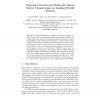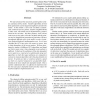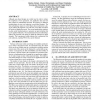3171 search results - page 4 / 635 » Application of Reduce Order Modeling to Time Parallelization |
NN
2007
Springer
14 years 1 months ago
2007
Springer
The signature of neuronal assemblies is the higher-order correlation structure of the spiking activity of the participating neurons. Due to the rapid progress in recording technol...
IPPS
2000
IEEE
14 years 1 days ago
2000
IEEE
Abstract. Computer simulations of realistic applications usually require solving a set of non-linear partial di erential equations
PDEs
over a nite region. The process of obtaini...
IPPS
2003
IEEE
14 years 28 days ago
2003
IEEE
We had introduced the massively parallel global cellular automata (GCA) model. Parallel algorithms derived from applications can be mapped straight forward onto this model. In thi...
ICCD
2004
IEEE
14 years 4 months ago
2004
IEEE
Although scan-based designs are widely used in order to reduce the complexity of test generation, test application time and test data volume are substantially increased. We propos...
JCNS
2010
13 years 6 months ago
2010
Accurately simulating neurons with realistic morphological structure and synaptic inputs requires the solution of large systems of nonlinear ordinary differential equations. We ap...




